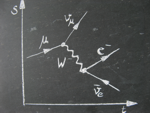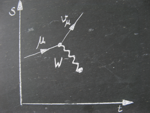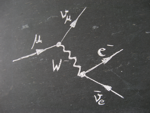Varianta W

The following picture gallery contains the information about Feynman diagrams necessary to understand the explanations on the following pages. This information uses the muon as an example. The muon is a popular particle among physicists, although unknown to most human beings. It is produced in collisions of cosmic particles with the atoms of the atmosphere and flies through our body on its way down. At sea level one can measure about one muon per minute within an area the size of a finger nail. (How many muons cross your body within a year?)
The 3 images on the left illustrate the sequence of the decay of the muon, and the last image depicts a muon-antimuon annihilation.
As a matter of fact, Feynman diagrams (proposed and developed by Richard Feynman – Nobel Prize in Physics 1965), are depictions of decays and interactions between particles, with a proper mathematical treatment described by quantum field theory. Using these pictures, complicated processes can be illustrated and occurrence probabilities can be computed more easily.
Here you get back to the beta decay website.
Here you get back to the W particle website.



